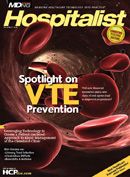The Net Guide: Clostridium difficile
Profiles of online resources, complete with links, that focus on clostridium difficile and associated diseases.
The Educated PatientAntibiotic-associated Diarrhea
Patients who experience antibiotic-associated diarrhea, a condition that is normally mild but may lead to colitis or pseudomembranous colitis, can obtain helpful information at this Mayo Clinic site. Visitors can learn about the symptoms, causes, risk factors, and complications of antibiotic-associated diarrhea, along diagnostic and treatment information. Also available is a list of steps patients can take when preparing for an appointment, what to expect during a visit, questions to ask a physician, and lifestyle modifications for coping with diarrhea.
Medical WebsitesClostridium Difficile Colitis
Visit this eMedicine site to increase your knowledge of Clostridium difficile, “a gram-positive, anaerobic, spore-forming bacillus that is responsible for the development of antibiotic-associated diarrhea and colitis.” In the article, lead author Faten N. Aberra, MD, of University of Pennsylvania School of Medicine, describes the pathophysiology, prevalence, and mortality/morbidity associated with C. difficile; differential diagnosis and workup; treatment and medication, including dosing, interaction, and contraindications for each type of antibiotic; and follow-up care instructions. Users can also link to related articles, including “Pseudomembranous Colitis, Surgical Treatment” and “Pseudomembranous Colitis.”
Clostridium Difficile Infections in Healthcare Settings
Need a primer on Clostridium difficile? Check out this page from the CDC, which provides a fact sheet explaining the various C. difficile diseases and their clinical symptoms, which patients are at an increased risk for C. difficile-associated disease, lab tests commonly used to diagnose these diseases, how C. difficile is transmitted and treated, and how it can be prevented in the hospital setting. Also included is a document providing information about the current strain of C. difficile, and presentations that can be downloaded, including “Changing Epidemiology and Prevention of Clostridium difficile Infection.”
Clinical TrialsStudy of a Clostridium Difficile Toxoid Vaccine in Subjects with Clostridium Difficile InfectionStudy Type: Interventional
Age/Gender Requirements: 18-85 years (male/female)
Sponsor: Sanofi-Aventis
Purpose: To obtain information on the preliminary efficacy, safety and immunogenicity of ACAM-CDIFF vaccine, as compared to placebo in adult patients who are experiencing their first event of CDI and are being treated with the antibiotic standard of care.
eAbstractsClostridium Difficile in Patients Undergoing Primary Hip and Knee ReplacementJournal: Journal of Bone and Joint Surgery (July 2010)
Authors: Jenkins P, Teoh K, Simpson P, et al
Purpose: To determine the incidence of patients who develop Clostridium difficile-associated disease (CDAD) following joint replacement, using a cefuroxime-based regimen.
Results: Researchers found that patients who received additional antibiotics had a higher incidence of CDAD; however, there was no difference between these patients and the control term in terms of the use of gastroprotective agents. It was concluded that cefuroxime-based antibiotic prophylaxis is safe in patients undergoing primary elective joint replacement.
Avoiding Colectomy during Surgical Management of Fulminant Clostridium difficile ColitisJournal: Surgical Infections (June 2010)
Authors: Olivas A, Umanskiy K, Zuckerbraun B, Alverdy J
Purpose: To advance clinical knowledge of the surgical management of fulminant C. difficile colitis—which is associated with poor mortality rates—and to provide alternatives to total abdominal colectomy for treatment.
Results: A review showed that several factors contribute to the high postoperative mortality rate: “Surgical intervention too late in the course of the disease, lack of clearly defined guidelines for patient selection, and difficulty in predicting the clinical course of the disease.” Researchers state that “a high clinical suspicion and careful patient selection for colectomy is imperative to improve postoperative survival,” and identified laparoscopic creation of an ileostomy with total colonic washout as an alternative to surgery.
Pharma Focus
Alinia (Nitazoxanide)
Clinical Trials
Compassionate Use of Nitazoxanide for the Treatment of Clostridium Difficile InfectioStudy Type: Interventional
Age/Gender Requirement: 18 years (male/female)
Sponsor: Baylor College of Medicine
Purpose: Nitazoxanide has been approved by the FDA as an antiprotozoal agent for oral administration in patients ages one through 11 with diarrhea; this phase III trial seeks to determine whether nitazoxanide is safe and effective for the treatment of diarrheal disease due to C. difficile infection when previous treatment with metronidazole or vancomycin has failed.
